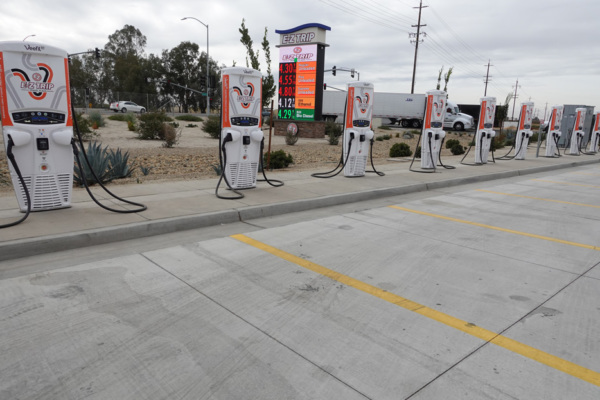State departments of transportation are in charge of distributing Electric Vehicle Charging Funding under the federal Infrastructure Investment and Jobs Act (IIJA).
State DOTs have a short window to develop their "EV charging plans" that will outline their respectives approaches to distributing those funds.
It is critical to have a seat at the table as your state DOT develops its plan, which must be submitted to U.S. DOT by August.
NATSO members should contact their state transportation departments promptly to learn about their EV charging plans and to share our industry's perspective on what a successful plan should look like.
Points to Share With Your State DOT
- States should encourage, incentivize, and support the use of the existing refueling network and its business model to build a network of electric vehicle charging stations while also facilitating the ability of new entrants to join the-competitive market. The market dynamics that govern today’s liquid retail fuel sector should be replicated to facilitate greater EV charging investment.
- Range anxiety does not exist for drivers of gasoline or diesel-powered vehicles. Private sector fueling locations ensure that drivers of gasoline-powered cars do not have concerns about how many miles they can drive before refueling. A similar approach will drive demand for electric vehicle charging stations. Availability of EV charging stations at existing retail fuel outlets is the most effective way to eliminate range anxiety.
- Fuel retailers compete with one another on price, speed, quality of service and amenities every day. The EV charging experience should be as similar as possible to today’s refueling experience to ensure a competitive marketplace and to ensure a transparent, cost-competitive price for electric fuel. The type of amenities and experience available to consumers while they charge their vehicle is critical. State DOTs should consider the time it takes to recharge an EV. Instead of a five minute “stop,” this will be a 30-minute “experience.”
- To effectively prompt fuel retailers to invest in EV charging stations, states should establish policies that incentivize the industry to incorporate fast EV charging into its suite of fueling options.
- The vast majority of truckstops, travel plazas and off-highway fuel retailers are situated less than a mile from an Interstate exit. State DOTs must prioritize locations within one mile of an Interstate exit to fulfill their obligation of installing EV charging infrastructure every 50 miles along the state’s portions of the Interstate Highway System within one travel mile of the Interstate.
- State DOTs should prioritize grant applications that involve companies putting private capital at risk to own and operate charging stations. State DOTs should direct money toward projects that have a more competitive market structure, rather than projects where regulated utilities increase monthly utility bills to all customers (otherwise known as ratepayer capital) to generate a competitive advantage in retail charging operations.
- Applications for grant funds from utilities that rely on ratepayer supported funding to own and operate EV charging stations should not receive grant money to cover the installation and operating costs, unless there are no other applicants seeking the money (in which case utilities could step in to ensure an adequate build-out of the charging network.)
- Projects should be structured in a “make-ready” model. This means utilities may use ratepayer money to underwrite “above-the-meter” investments in grid and distribution capacity to accommodate charging stations, but the charging stations themselves should be funded and operated without ratepayer subsidization.
- For the private market to work, there must be a pathway to retailers buying electricity at wholesale prices without punitive demand charges. This must include adopting electricity tariffs that support those partnerships through simple, controllable electricity costs. Electricity markets will have to provide reliable, transparently priced wholesale electricity to EV charging site hosts at their full capacity. Congress has directed states to consider ways to offset demand charges.
- A robust and competitive EV fast charging marketplace depends on a level playing field. Off-highway fuel retailers will not invest in EV charging infrastructure if states are permitted to operate a monopoly and offer EV charging from an unfair location directly on the Interstate right-of-way. We encourage states to adhere to established federal law that prohibits commercialized rest areas as well as FHWA guidance which clarified that state transportation departments may not implement or permit others to implement commercial services, including EV charging stations, within the Interstate right-of-way.
Reach out to LeeAnn Goheen, NATSO’s director, government affairs at lgoheen@natso.com or (703) 739-8561 for more information and assistance.
Provided by NATSO—the national trade association representing truckstops, travel plazas and other off-highway transportation energy retailers. Visit www.natso.com/grants for more Infrastructure Investment and Jobs Act (IIJA) EV Charging Funding Opportunities for Truckstop and Travel Plaza Operators information.
Subscribe to Updates
NATSO provides a breadth of information created to strengthen travel plazas’ ability to meet the needs of the travelling public in an age of disruption. This includes knowledge filled blog posts, articles and publications. If you would like to receive a digest of blog post and articles directly in your inbox, please provide your name, email and the frequency of the updates you want to receive the email digest.

